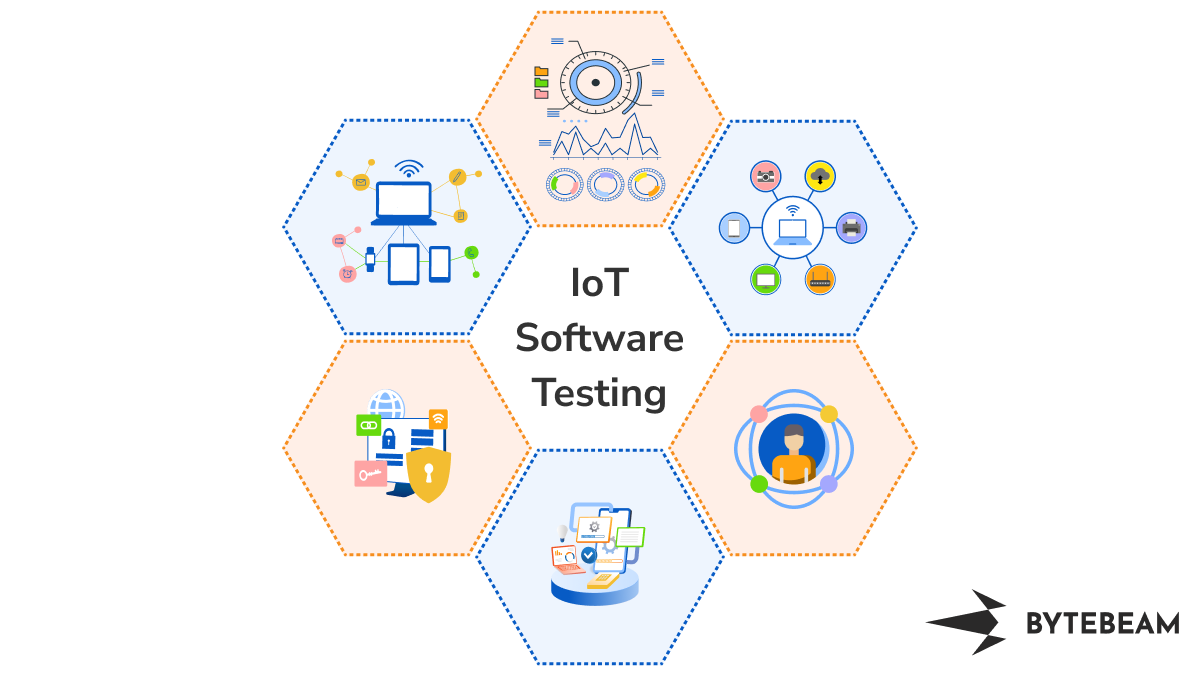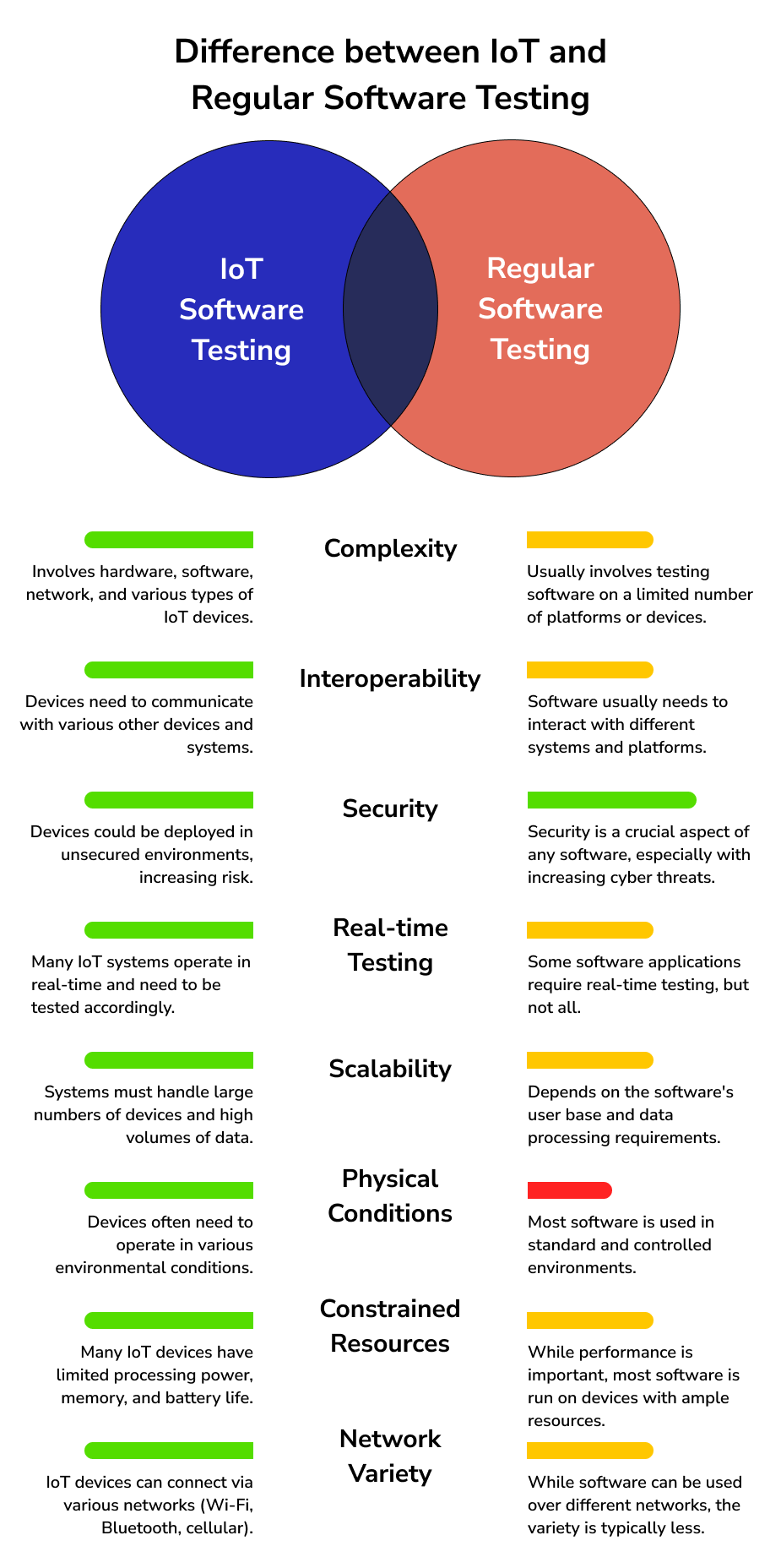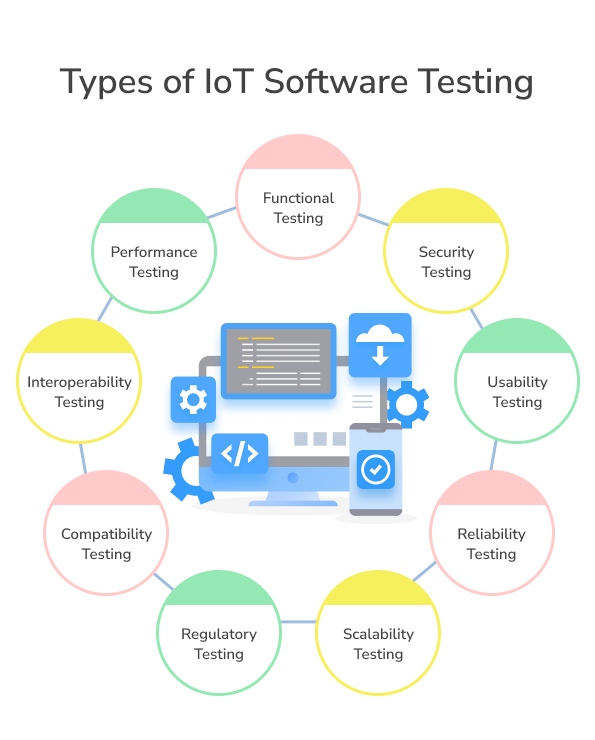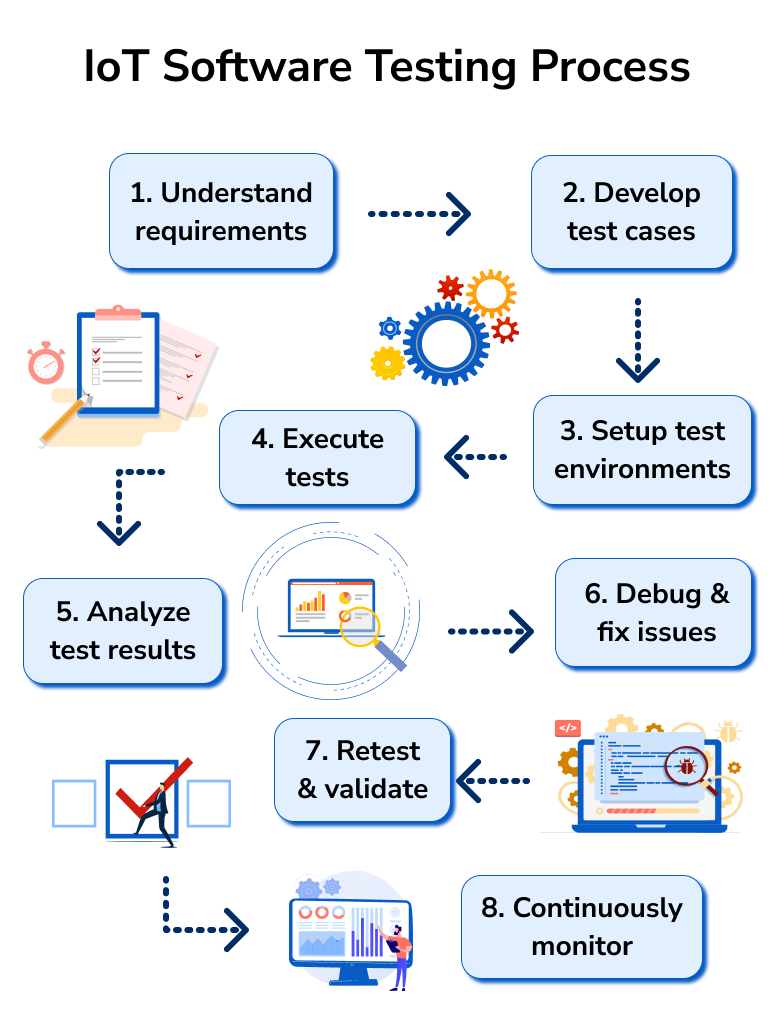A Complete Guide for IoT Software Testing
Discover our complete guide to IoT Software Testing, covering everything from basics to advanced techniques. Learn how to ensure the efficiency, security, and performance of IoT devices and applications, paving your way to a successful IoT implementation.

Have you ever wondered who makes sure that all the connected devices work properly?
It is a process acting as the saviour behind the scenes known as IoT software testing.
As of May 2023, there are approximately 15.14 billion connected IoT devices worldwide. This number is expected to almost double to 29.42 billion by 2030.
IoT software testing is the process of ensuring that these billions of IoT devices and applications work as intended. It is a complex and challenging process, which is only made more complex by the unique characteristics of IoT devices and applications.
What to expect: In this comprehensive guide, we will delve into the world of IoT software testing, discussing its need, process, challenges, and best practices. We intend for this to be a starter’s guide for anyone looking to understand the process better.
What is IoT Software Testing
Like any other piece of technology, IoT devices are powered by software—the instructions that tell the devices what to do and how to do it. And just like any other software, it needs to be tested to make sure it works correctly, securely, and efficiently. That's where IoT software testing comes in.
IoT software testing involves checking the functionality, performance, security, and user experience of IoT devices. In a nutshell, IoT software testing is all about making sure your internet-connected devices work as intended, no matter the circumstances. This involves checking that they can interact with each other and the internet, handle various environments, provide a good user experience, perform well, scale up when needed, and remain secure from potential threats.
The need for IoT software testing
IoT software testing can be a complex endeavor, and here's why:
- Different Environments: IoT devices operate in varied environments. For instance, a wearable fitness tracker experiences different conditions than a smart thermostat. Therefore, testing needs to account for these different environments.
- Interoperability: IoT devices often need to interact with other devices or systems. For example, your smartwatch may need to send data to your smartphone. This interaction needs to work smoothly and correctly.
- Security: IoT devices can be vulnerable to security risks because they're connected to the internet. Therefore, it's crucial to test for potential security issues.
- Performance: IoT devices must perform well and respond quickly to commands, especially when they are managing critical tasks. For example, a smart smoke detector must alert you instantly if it detects smoke.
- Scalability: As you add more IoT devices to your network, the system must be able to handle the increased load.
- User Experience: IoT devices need to be user-friendly and provide a seamless user experience.
Difference between regular software testing and IoT software testing
Think of this regular software testing as proofreading a book. You're checking for mistakes, making sure everything makes sense, and that the story flows smoothly from start to finish. The book (software) exists in one form, and you can control where and when you're checking it.

For IoT software testing, you will have to imagine you're not just proofreading a book, but a whole series of comic books. These comics (IoT devices) are not only telling their own stories but also interacting with each other. Sometimes, the plot in one comic might affect what happens in another. Moreover, these comics aren't just sitting in your room. They're out in the world experiencing different weather, being read by different people, and so on. So, you need to check not just each comic individually but also how they interact with each other and how they handle different conditions outside.
Factors like Interoperability, hardware-software interaction, connectivity, and more makes IoT software testing a much more complex process.
Types of IoT Software Testing
In order to ensure the reliability, functionality, and efficiency of IoT systems, different types of testing are performed on IoT devices. Here are some of the most common types of IoT software testing:

Functional Testing: This checks whether the IoT device is working as intended. It includes testing the device's features and capabilities to ensure they meet specified requirements.
Performance Testing: This examines the speed, responsiveness, and stability of an IoT system under a particular workload. It can also involve stress testing, where the system is tested under extreme workloads to see how it handles high traffic or data processing.
Security Testing: Given that IoT devices are often connected to the internet, they can be vulnerable to attacks. Security testing checks for potential vulnerabilities in the system that could be exploited by attackers.
Interoperability Testing: This ensures that IoT devices can effectively communicate and operate with other devices or systems. Given the varied manufacturers and protocols in the IoT ecosystem, this is crucial.
Usability Testing: This focuses on the user's experience. It checks the system's ease of use, intuitiveness, and overall user interface. For an IoT device to be successful, it must be user-friendly.
Compatibility Testing: This testing ensures that the IoT device can operate effectively in different environments and with different hardware, operating systems, network configurations, etc.
Reliability Testing: This verifies that the IoT device can perform a task consistently over time without failure.
Regulatory Testing: This is often a part of IoT testing because IoT devices frequently collect and store personal data, like health stats or information about home habits. These devices need to comply with various privacy and security regulations, such as GDPR in Europe or CCPA in California, USA. Regulatory testing ensures that the devices meet these legal requirements to protect user data and privacy.
Scalability Testing: As the number of devices connected to the IoT network can grow rapidly, it's important to test if the system can handle this growth. Scalability testing checks how the IoT system performs under an increased load, for instance, when new devices are added to the network.
This range of testing ensures that IoT devices and systems work as expected, provide a good user experience, perform well under different conditions and workloads, remain secure, and comply with necessary regulations.
IoT Software Testing Process
The process of IoT device testing involves a combination of different strategies and methodologies, tailored to the specific requirements of the IoT system. To understand the process, let’s use the example of a smart home automation system. In this scenario, the smart home system consists of various IoT devices such as smart lights, thermostats, security cameras, and a central hub that connects and controls these devices.

Understanding Requirements
The first step involves understanding the functional and non-functional requirements of the IoT system. What is the purpose of the system? What features does it need? How should it perform? Understanding these requirements is key to developing effective test cases.
So the testing team analyzes the requirements of the smart home system, including functionality, performance, security, and interoperability aspects. For example, the requirements may include turning on/off lights, adjusting thermostat settings, detecting motion through security cameras, and ensuring secure communication between devices.
Developing Test Cases
Based on the requirements, test cases are developed. A test case is a set of conditions or variables under which a tester will determine whether the IoT system functions correctly or not.
For instance, the test plan may include test cases to verify the proper functioning of each device, test the integration between devices and the central hub, and assess the system's performance under different scenarios.
Setting Up the Test Environment
The next step in IoT device testing involves setting up a test environment that mimics the real-world conditions in which the IoT devices will operate. This could include configuring the smart home devices, connecting them to the central hub, and creating a simulated home environment. This may involve deploying physical devices or using emulators and simulators to mimic the behavior of IoT devices.
Executing Tests
The tester then executes the test cases in the test environment. This includes running the software on the IoT devices and checking if they behave as expected.
For instance, a test case may involve sending commands from the mobile app to the central hub, which then communicates with the smart light to turn it on/off. The expected behavior is observed and compared with the desired outcome.
Different types of IoT device testing will be undertaken differently here:
- Performance Testing: Performance testing is conducted to evaluate the system's responsiveness and scalability. For example, multiple users may simultaneously interact with the smart home system to assess its performance under high load. This may involve monitoring response times, data transfer rates, and resource utilization.
- Security Testing: Security testing is performed to identify vulnerabilities in the smart home system. This can include checking for weak authentication mechanisms, testing for potential data breaches or unauthorized access, and analyzing the security of data transmission between devices and the central hub.
- Interoperability Testing: Interoperability testing verifies the compatibility and communication between different devices within the smart home system. For example, test cases may involve ensuring that the smart lights can be controlled through both the mobile app and voice assistants like Amazon Alexa or Google Assistant.
- Usability Testing: Usability testing focuses on evaluating the user-friendliness of the smart home system. Testers assess the ease of device setup, the intuitiveness of the mobile app or user interface, and the overall user experience when interacting with the system.
Analyzing Test Results
After executing the tests, the results are analyzed to identify any defects or issues. Any failures are documented with detailed information about the conditions under which the failure occurred.
Debugging and Fixing Issues
If any issues are identified, they need to be debugged and fixed. This might involve software developers making changes to the code, or it could involve hardware modifications.
Re-testing and Validation
After issues have been fixed, the tests are run again to ensure that the problems have been resolved. This is a part of the validation process to ensure the system is working as expected.
Continuous Monitoring and Testing
Given that IoT systems often operate in dynamic environments and have frequent updates, continuous monitoring, and testing are critical. This helps to ensure the system continues to perform well over time and under different conditions.
Alternative Methods
In our experience, the development of software simulators for hardware devices has been a game-changer for IoT software testing. It's like having a digital twin of the physical device that allows us to conduct tests without the need for deploying real-world hardware. We can evaluate our system's performance and functionality with the simulator, making the process not just more manageable but also cost-effective.
Scalability testing is made significantly easier with these simulators. Picture having a room full of robots but in a virtual space. You can quickly duplicate these virtual robots to simulate many devices, a feat that's much more challenging and expensive with real hardware.
To add another layer of complexity, you can also utilize network simulators, which act like artificial storm makers for the IoT ecosystem. They allow you to create rough digital seas by simulating poor network conditions. These storms give us the ability to rigorously test our system's data reliability and resilience, ensuring our backend systems can navigate through rough waters gracefully.
Overall, the process of IoT software testing is inherently more complex than regular software testing.
Why? Because IoT devices are like little explorers that can be in various conditions, their physical nature makes the testing process slower and more challenging. Imagine these devices as social beings—they interact with each other, which further complicates the test setup. But with simulators, we manage to make the process more efficient and comprehensive, ensuring our IoT systems perform optimally under any circumstances.
Challenges in IoT Software Testing
IoT testing involves several challenges due to the inherent complexity of IoT systems, which include multiple devices from various manufacturers, operating in different environments, and communicating via different protocols. Here are some of the key challenges associated with IoT testing:
Device Diversity and Interoperability
IoT systems involve devices from different manufacturers, each with its own software and hardware specifications. Ensuring that these devices can communicate and work together can be difficult. Imagine trying to get a group of people from different countries, speaking different languages, to work together on a project. It's the same with IoT devices - they're all a bit different, and getting them to communicate and work together can be tough.
Network Connectivity
IoT devices often rely on network connections to function. Ensuring that the software performs reliably across different network conditions can be challenging.
Real-time Complexity
Many IoT applications have real-time processing requirements. It is trying to catch a baseball while running. Some IoT devices need to process information in real-time, and making sure they can do this effectively is a challenge.
Security
IoT devices, like your home's smart lock, need to be secure to protect against thieves. Ensuring these devices are safe from different types of 'attacks' is a major concern for the following reasons:
- Increased Attack Surface: Think of each IoT device as a door. The more doors you have in a house (the internet), the more ways there are for a thief (a hacker) to try and get in.
- Different Security Levels: Not all IoT devices are made the same. Some might have strong locks (good security), while others might have weak ones or even be left unlocked. This inconsistency makes it hard to ensure overall security.
- Quick Evolution: IoT is growing and changing fast, like a house that's constantly having new doors added. Each new type of device can bring new security issues with it.
- Lack of Standardization: There's no single set of rules for how to make and lock all the doors. This lack of standard security measures across the industry makes it tough to keep every device secure.
- User Behavior: Sometimes, the people using the devices might leave a door unlocked accidentally by not following good security practices. For instance, they might use easy-to-guess passwords or not update their device software.
- Data Privacy: These devices often handle sensitive data, like when you're home or what your health stats are. Keeping that data secure is a big responsibility and a major challenge.
So, securing IoT devices is like trying to keep a gigantic, ever-changing house with thousands of doors safe from skilled thieves. It's a tough job, but it's incredibly important to prevent data theft and maintain user trust.
Scalability
IoT systems can rapidly increase in size. Ensuring that the system can handle this growth and perform effectively under increased load is a major challenge.
Imagine trying to coordinate a large, diverse choir where each member is singing a different song, in a different language, and at a different volume. Now, you also have to ensure that no one sings out of tune, and the music hall doesn't become too crowded. That's the scale of the challenge we're talking about with IoT testing scalability.
Environment variation
IoT devices operate in various environments, each with its own unique conditions. Testing the devices in all possible environments to ensure they function correctly can be challenging and often impractical.
Power consumption
For battery-powered IoT devices, power consumption is a critical factor. Testing how software changes affect battery life can be tricky.
Data volume
IoT devices can generate a huge amount of data. Testing the system's ability to handle and process this data efficiently is a significant challenge.
Standardization
There are currently no universally accepted standards for IoT, making it challenging to define the correct behavior for all scenarios.
Overcoming these challenges often requires a combination of different IoT device testing strategies, thorough planning, and the use of specialized testing tools tailored for IoT systems.
Best Practices for IoT Software Testing
While you may come across several challenges, there are a few things you can do to ensure that your IoT testing process is as smooth as it can be.
- Adopt a Risk-Based Testing Approach: In this approach, the features and functionalities of the IoT system that carry the highest risk are tested first. This ensures that the most critical components of the system are well-tested and functional.
- Test Early and Often: Testing should start as early as possible in the development process and be performed regularly. This allows for early detection of defects and issues, making them easier and cheaper to fix.
- Implement a Continuous Testing Process: IoT systems are dynamic and often updated. Continuous testing ensures that any changes, updates, or additions to the system are tested promptly, maintaining the overall quality of the system.
- Prioritize Security Testing: Given the potential vulnerabilities of IoT devices, security testing should be a high priority. This includes testing for potential breaches, data leaks, and ensuring compliance with relevant regulations.
- Leverage Automation Where Applicable: Automated IoT testing tools can perform a large number of tests quickly and accurately. They are particularly useful in large, complex IoT systems.
- Collaborate and Communicate with All Stakeholders: Effective communication between all parties involved - including developers, testers, project managers, and clients - is essential for a successful testing process.
IoT testing is a continuous, well-planned process that emphasizes risk management, security, and efficient use of resources. It should be integrated early into the development process and involves good communication among all stakeholders.
Final Thoughts
In an IoT ecosystem, each device is like a small robot. They have to talk to each other, share information, and work together without messing things up. Software testing is like the final check to make sure they'll do their jobs right. It helps ensure that these devices can communicate properly, keep our data secure, work efficiently without using too much power, and perform well even when there are a lot of them in use at once.
Without testing, we could end up with devices that don't work as expected, break down, or even expose our data to hackers. So, in essence, IoT software testing is essential to make sure the 'robot' behaves as it should, helping to keep the IoT ecosystem running smoothly and safely.
If you enjoyed reading about the ins and outs of IoT software testing, subscribe to our blog where we publish IoT specific content every week!

